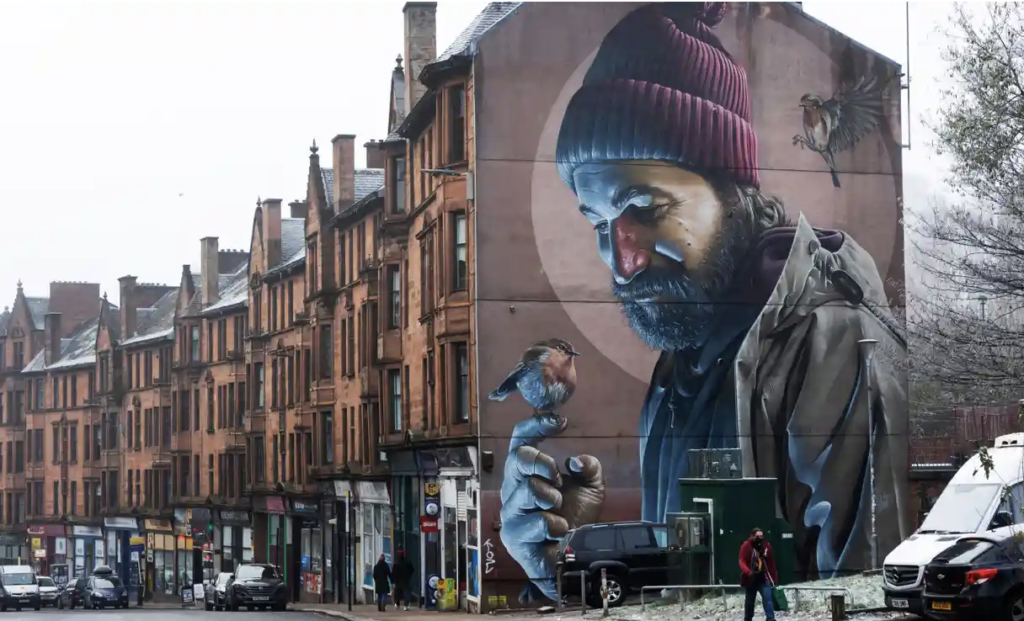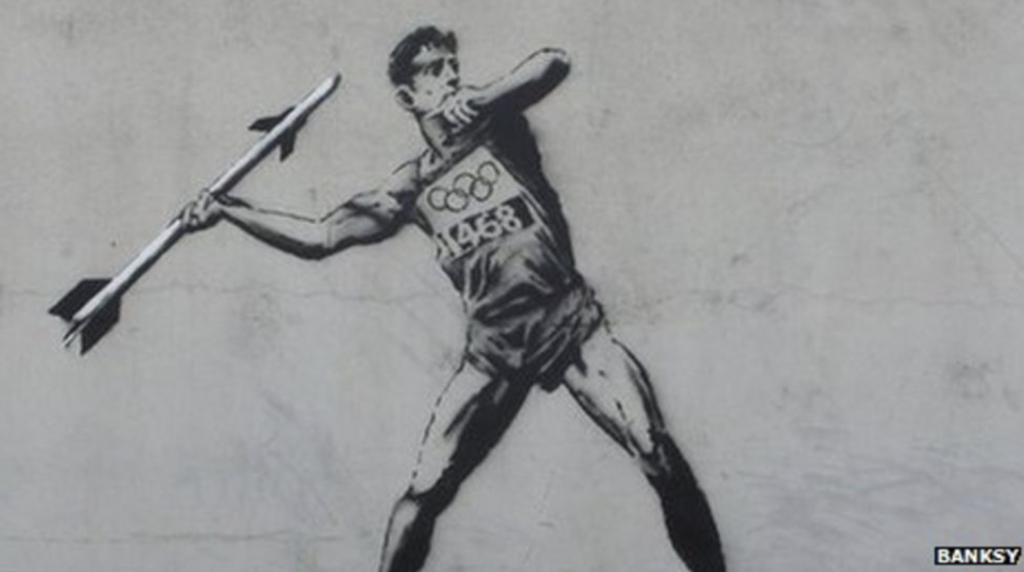Urban art – vandalism or artwork?
written by art historian & curator
Street art, mural art, urban art, or graffiti are several definitions describing mainly the same thing: visual creations on walls, windows, columns, pillars, and many other corners belonging to both public and private spheres. Normally, public artistic creations are welcomed by society. But this genre is not yet accepted by all parties. By pursuing an artistic desire, some artists risk being arrested or get fined. Other artists work only at nighttime when the dark is hiding their identity.
So why is graffiti such a debated issue? Why is graffiti, if it has such a strong illegal component, still attractive to artists? As a matter of fact, if graffiti works are perceived as something negative, are their creators still artists or vandals? The question ” Is graffiti vandalism or art?” arises in societies across the globe. To their creators, graffiti is an expression of creativity, of personal identity, of being part of some sort of underground culture. It seems that the excitement mixed with anxiety describes a rebellious attitude of the creators aimed at a precise target. Sometimes the possibility of being arrested is also luring the artists into this activity.
Join our free online talks:
From a larger point of view, street art is an artistic manifestation with powerful social content revealing times of great adversity. History has shown us that when difficult periods occur, when wars are being fought, pandemics arise or political protests take over the streets, this is a moment when a cultural turning point occurs. Artists have always been at the front of the movements that brought change and progress. Through their ideas and artistic creations, artists have provoked a scandal, broken the law, and induced chaos but they helped society to move forward.
We will consider graffiti from multiple perspectives, both legal and illegal, political and artistic, isolated or international. Could this genre that mirrors, critiques, and incorporates everyday events be an expression of the bigger picture and not just a momentary act without meaning?
Differences between graffiti and urban art
In a city, graffiti blends into the everyday life of the neighbourhood. It is natural, appreciated, and justified by young generations. Many businesses use graffiti as a way of local branding. Graffiti is represented by forms of writing, drawing, or scratching onto surfaces using techniques such as paint, markers, stickers, and stencilling.

Official definitions state that graffiti work is an act done outside the law due to the lack of permission to paint or tag on public or private bodies. Think about the following situation. If someone sprayed on your house or fence without your permission, would you like that? This is a classic example of graffiti as vandalism because it is an action involving the deliberate destruction of non-personal goods. It has nothing to do with the quality of the work but with legal issues.
Banksy is a worldwide renowned street artist, anonymous and who constantly challenges the authorities. His murals were sold at auction houses for millions of dollars and yet many of his works were removed from public bodies. Neither the fame of the artists nor their exceptional creative skills matter in this interpretation. So regardless if the public accepts it or loves it, according to the law, graffiti without permission is an act of vandalism.
How about if the artist has permission? The permission to realise an amazing artwork on a dull wall. Is graffiti now art? Not quite. It seems that many public authorities define graffiti as illegal or vandalism as long as this act is being done without permission while authorised street artwork is named Urban art. Urban art benefits from having permission to mark public or private surfaces. On some occasions such as the London Olympic games, authorities legally permitted graffiti works to decorate streets and walls. However, the project was made under the consideration that the creations were urban art, not graffiti. The decision was part of a strategy to present the effervescent cultural environment of urban London. The event was treated mainly as an artistic event and benefited from active curation by a team commissioned by the Olympic official art body. So, a natural question arises: is all graffiti destructive?

Sure, not all graffiti is good just as not all art is beautiful. Nowadays, street artists tend to suggest skilled individuals who do more than just an average scribble. They are also more interested in making political commentaries or social analyses thus, conveying meaningful messages. Contemporary vivid cities often include Urban Art in their strategies of management and development. Local councils and official authorities sometimes recommend offering permission for graffiti in special areas to prevent its illegal manifestations.
Double standards in perceiving graffiti artists
British law specifies graffiti as an anti-social behavior (the Anti-Social Behaviour Act of 2003). But, despite the definition, in the UK there are double standards in terms of perceiving graffiti. Even the law created breaches for some of the famous artists to escape penalties while others were fined or arrested.
In 2008 the Tate Modern broke the ice and commissioned the world’s first important museum display of mural art. The management team called for six international artists to decorate its facade with mural art. This might have been a response to the controversial 11 years of prison prosecution issued by the Southwark crown court for graffiti-related damages.
In Melbourne, Australia, the authorities made local surveys to find out the residents’ opinions about graffiti. The results showed that 71% of the participants considered graffiti a form of vandalism. However, 54% of participants stated that public art in general and street art in particular benefits the community. As a consequence, the council is looking to implement a 4-year strategy to integrate graffiti into city life in a politically correct way.

There are antecedents. In Moreland, a community-oriented public art project was developed and artists were asked to paint the traffic signal boxes. In Stockholm, legal urban festivals are held yearly to create and promote street art. In Latin America street art is not just an expression of youth but is intertwined with the Latin tradition that is almost impossible to separate one from another. Los Angeles recently passed an ordinance regarding mural art stating that street art is legal as long as the artist pays for a permit and gets permission from the location.
Conflict and Adversity
Buenos Aires is said to be the perfect example of a city built on graffiti. The walls talk about people, stories, and the country’s turbulent history. This is a particular case where graffiti was a tool used by both the politicians and the resistance. Graffiti became a means of communication for the citizens who were part of the resistance movement against the military dictatorship. Until today Argentinian laws forbid graffiti works, but paradoxically, the city is worldwide renowned for its excellent urban art.
Some of the most significant art movements in history emerged during difficult times. The political regime in Buenos Aires harnessed artistic mediums in the service of the community and delivered artworks with profound meaning and highly valuable social content. Graffiti became the voice of the people. Likewise, in other periods art survived and flourished. While the plague was devouring Europe, Renaissance art was celebrating life. The French Revolution put an end to the monarchy and the Realism movement celebrated ordinary life in all its glory. Anti-war movements gave birth to DADA, an avant-garde group of artists who fought against war and its followers. DADA was not only provocative to society but challenged even the basic notion of art.

Social Realism, Pop Art, Performance, Installations, and Street Art but not limited to this have been in between conflict and adversity. Conflict because art is sometimes born due to special social conditions, conditions that forced artists to stand up for justice, freedom, and human values. Adversity because art is giving an example of how to overcome adversity and learn from it. Thus, graffiti in some way is much more than just a juvenile tag. It is the reflection of how society is changing and of how new generations transform our world. We can read from their stories on the walls what they fear, what they like, and what are their concerns and maybe we can spot a future cultural direction. By communicating directly to the audience, street artists are constantly relevant to society in terms of message and beautifying the urban landscape.
Graffiti will remain in a conflictual area for some while although it is more and more worldwide appreciated. Just like art is a matter of taste, debating about what is pleasant or permissible for the environment and societal culture is also a spiny issue that is unlikely to be agreed upon by all parties.
GET MORE FROM LEVEL


Leave a Reply